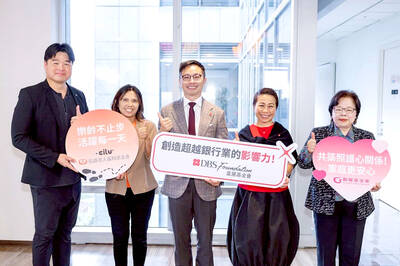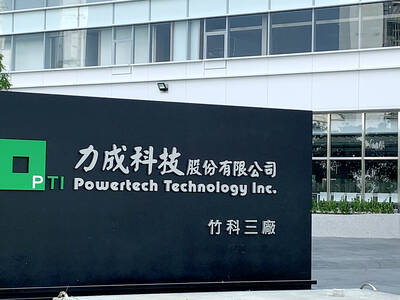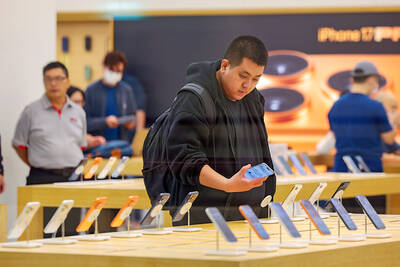At a factory in Finland, the “farmers of the future” are making a new food protein by feeding a microbe air and electricity, proving that protein can be produced without traditional agriculture.
Livestock farming is one of the main culprits in greenhouse gas emissions, the primary cause of climate change. Cellular agriculture, where food or nutrients are grown from cell cultures, is increasingly seen as a green alternative to animal agriculture.
Lab-grown meat, eggs and milk have made headlines over the past few years, with scientists using animal cell cultures — a process some have criticized as unnatural, highly processed, energy-consuming and costly.

Photo: AFP
However, at Solar Foods’ new factory outside Helsinki, scientists are using new technology to grow protein out of cells using air and electricity.
By feeding a microbe with carbon dioxide, hydrogen and some minerals, and powering the process with electricity from renewable sources, the company has managed to create a protein-rich powder that can be used as a milk and egg substitute.
“We can source our main feedstock for the microbe from the air,” Solar Foods chief executive officer Pasi Vainikka said, as he gave a tour of the company’s new facilities.

Photo: AFP
“We have started the production of the world’s most sustainable protein,” he added.
Founded by Vainikka and Juha-Pekka Pitkanen in 2017, Solar Foods launched the “world’s first factory growing food out of thin air” last month.
“Much of the animal-like protein of today can actually be produced through cellular agriculture and we can let agricultural land rewild and thereby build carbon stock,” Vainikka said, referring to the process whereby forests and soil absorb and store carbon.

Photo: AFP
One kilogram of the new protein, dubbed “solein,” emits 130 times less greenhouse gases than the same amount of protein produced by beef production in the EU, a 2021 scientific study said.
Vainikka navigates his way through the factory’s laboratory and into the control room, where a dozen people at computer screens monitor the production process.
“These are our future farmers,” Vainikka said.
Transforming food production and consumption is at the heart of combating the climate crisis and preventing biodiversity loss, said Emilia Nordlund, head of industrial biotechnology and food research at the VTT Technical Research Centre.
However, current projections show the consumption of meat is expected to increase in coming years.
“Industrial food production, especially livestock production, is one of the biggest causes of greenhouse gas emissions [and] the biggest cause of biodiversity loss, eutrophication and freshwater usage,” she said.
New food production technologies can help cut emissions and “decentralize and diversify food production,” Nordlund said.
“However, at the same time, we must improve the existing food production methods to make them more sustainable and resilient,” she added.
Fermentation technology used to produce nutrients, such as proteins, has been around for decades.
However, the field has expanded significantly over the past few years, with new technological solutions and research projects emerging worldwide.
Some of the most active start-up hubs focusing on cellular agriculture are in the US, the UK, Germany, the Netherlands and Israel, Nordlund said.
“We are in a crucial phase as we will see which start-ups will survive,” she said, adding that stalling bureaucracy was slowing cellular agriculture’s take-off in the EU.
Dressed in protective gear to prevent bacteria contamination in the factory, Vainikka showed off a giant steel tank in a shiny production hall.
“This is a fermenter holding 20,000 liters,” he said, adding that the microbe multiplies inside the tank as it gets fed the greenhouse gas.
Liquid containing the microbes is continuously extracted from the tank to be processed into the yellowish protein-rich powder with a flavor described as “nutty” and “creamy.” “The fermenter produces the same amount of protein per day as 300 milking cows or 50,000 laying hens,” Vainikka said.
That equals “5 million meals worth of protein per year,” he said.
For now, the main purpose of the small Finnish plant employing about 40 people is to “prove that the technology scales,” so it can attract the necessary investments pending European regulatory approval.
While the protein has been cleared for sale in Singapore where some restaurants have used it to make ice cream, it is still awaiting classification as a food product in the EU and the US.
To have any real impact, the aim is to “build an industrial plant 100 times the size of this one,” Vainikka said.

US sports leagues rushed to get in on the multi-billion US dollar bonanza of legalized betting, but the arrest of an National Basketball Association (NBA) coach and player in two sprawling US federal investigations show the potential cost of partnering with the gambling industry. Portland Trail Blazers coach Chauncey Billups, a former Detroit Pistons star and an NBA Hall of Famer, was arrested for his alleged role in rigged illegal poker games that prosecutors say were tied to Mafia crime families. Miami Heat guard Terry Rozier was charged with manipulating his play for the benefit of bettors and former NBA player and

The DBS Foundation yesterday announced the launch of two flagship programs, “Silver Motion” and “Happier Caregiver, Healthier Seniors,” in partnership with CCILU Ltd, Hondao Senior Citizens’ Welfare Foundation and the Garden of Hope Foundation to help Taiwan face the challenges of a rapidly aging population. The foundation said it would invest S$4.91 million (US$3.8 million) over three years to foster inclusion and resilience in an aging society. “Aging may bring challenges, but it also brings opportunities. With many Asian markets rapidly becoming super-aged, the DBS Foundation is working with a regional ecosystem of like-minded partners across the private, public and people sectors

BREAKTHROUGH TECH: Powertech expects its fan-out PLP system to become mainstream, saying it can offer three-times greater production throughput Chip packaging service provider Powertech Technology Inc (力成科技) plans to more than double its capital expenditures next year to more than NT$40 billion (US$1.31 billion) as demand for its new panel-level packaging (PLP) technology, primarily used in chips for artificial intelligence (AI) applications, has greatly exceeded what it can supply. A significant portion of the budget, about US$1 billion, would be earmarked for fan-out PLP technology, Powertech told investors yesterday. Its heavy investment in fan-out PLP technology over the past 10 years is expected to bear fruit in 2027 after the technology enters volume production, it said, adding that the tech would

YEAR-END BOOST: The holiday shopping season in the US and Europe, combined with rising demand for AI applications, is expected to drive exports to a new high, the NDC said Taiwan’s business climate monitor improved last month, transitioning from steady growth for the first time in five months, as robust global demand for artificial intelligence (AI) products and new iPhone shipments boosted exports and corporate sales, the National Development Council (NDC) said yesterday. The council uses a five-color system to measure the nation’s economic state, with “green” indicating steady growth, “red” suggesting a boom and “blue” reflecting a recession. “Yellow-red” and “yellow-blue” suggest a transition to a stronger or weaker condition. The total score of the monitor’s composite index rose to 35 points from a revised 31 in August, ending a four-month